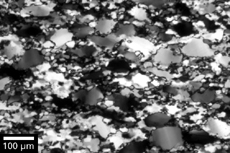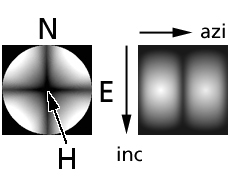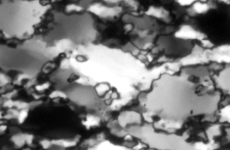1.3
WHAT IS ORIENTATION IMAGING ?
top / contents / section 1 / pages 1.1 -- 1.2 -- 1.3 -- 1.4 -- 1.5 -- 1.6 -- 1.7
... using crossed polarizers



The quartzite is shown under crossed polarizer conditions. Grains or pixels that appear black can have any c-axis orientation parallel to the East-West or the North-South plane, i.e., they can have any inclination provided the azimuth is 0° or 90°. Grains that appear grey to white can have any other orientation, striking approximately NE-SW or NW-SE.
The brightness-orientation relation is contained in the conoscopic image. The latter can be interpreted as the stereographic projection of the look-up table. The orthogonal representation of the look-up table is shown on the right.
Because of the symmetry of the consoscopic image, i.e., of the look-up table, there are always a number of possible c-axis orientations that can be found for any given grey value.
Left, from top to bottom:
- Experimentally deformed Black Hills quartzite under crossed polarizer conditions
- conoscopic image and look-up table for crossed polarizer conditions
- detail of micrograph... meet the chipmunk.